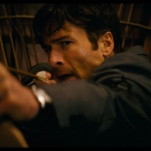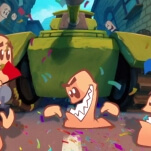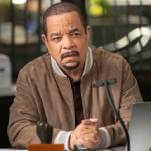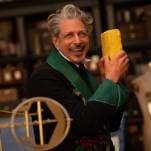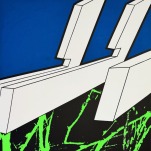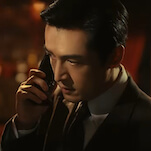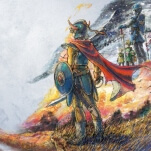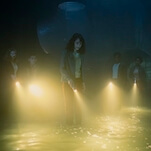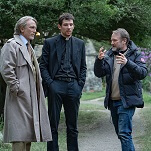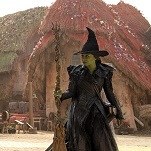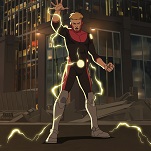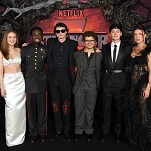“The Tsuranga Conundrum” is a relatively solid, somewhat strange episode of Doctor Who that serves as an effective case study in what separates a good episode of this series from a great one. Because it has to establish a brand new world each week, Doctor Who has to be even more efficient with its storytelling than most TV shows. Every second counts when it comes to creating an episode that feels truly lived-in rather than one that seems like a sketch of an expansive world. Though it has some high points, “The Tsuranga Conundrum” winds up feeling a bit more like an outline of a compelling episode rather than a fully compelling episode in and of itself. And that mostly comes down to how inefficiently the episode uses its opening 10-15 minutes.
Chris Chibnall makes two big mistakes in structuring the opening act of the episode. The first is wasting too much time on the Doctor’s half-crazed attempts to get back to her TARDIS once she realizes that she and her friends have been brought onboard a hospital ship after being rescued from a “sonic mine” blast. The second is putting too much focus on Astos, a character who quickly dies in order to up the episode’s stakes. Because Brett Goldstein and Jodie Whittaker have such great chemistry together and because there’s so much heft to the moment in which the Doctor apologizes to Astos for her selfishness, the episode seems to be setting up a story in which the Doctor and Astos negotiate their respective senses of authority while learning to work as a team. That the episode suddenly drops those elements to focus on something new leaves it feeling unbalanced. And just why did Astos’ jettisoned escape pod explode, anyway?
It’s not until about halfway through its runtime that “The Tsuranga Conundrum” gets to its titular conundrum: Trapped aboard the ship and headed towards a rescue base that will blow them up if they let on that they’re in trouble, the TARDIS team have to figure out how to stop an unstoppable alien force. From that point on, the episode is an effective little thriller with some intriguing players. Yet because of how it mismanages its opening 15 minutes, the episode constantly feels like it’s playing catch-up with the rest of its characters’ backstories. Having three companions would seem to offer an easy entry point for getting to know a big ensemble guest cast better, but “The Tsuranga Conundrum” only half commits to that idea as Graham, Ryan, and Yaz wander through this episode rather aimlessly. Perhaps having 10 central characters is just too much for one episode of Doctor Who to handle.
Thankfully, the performances help sell the thinly written character arcs. As famed pilot General Eve Cicero, Suzanne Packer adds real gravitas and dignity to the story of a 67th century legend plagued by the weight of a debilitating illness she’s trying to hide. Having the Doctor fangirl out over meeting Eve is a nice way to give an immediate sense of importance to the character. Indeed, though “The Tsuranga Conundrum” struggles with worldbuilding on an episode-wide level, it’s great at little details—like way the solemn way the Doctor and Eve discuss her “Pilot’s Heart” condition, which implies a lot without needing to stop for a lengthy monologue explaining what it actually is.
Elsewhere, “The Tsuranga Conundrum” offers some comic relief in Yoss (Jack Shalloo), an alien from a race where men have week-long pregnancies. It feels a bit like a gag from an ’80s movie (or, more specifically, a riff on Arnold Schwarzenegger’s Junior), but to its credit the episode finds some actual pathos in Yoss’ fears about becoming a parent and his debate over whether or not to give up his son for adoption. That, in turn, inspires Ryan to find some empathy for his absentee father, and, eventually, to find the words to convey to Yoss that being a good parent is more about being there for your kid than about being completely perfect all the time.
Tonally, “The Tsuranga Conundrum” walks an interesting line between comedy and drama—both in Voss’ storyline and with its central monster. Though it initially feints at being something of an Alien-style space horror story (director Jennifer Perrott uses a handheld style to immerse us in the action), the reveal of the Pting hilariously undercuts that initial tension. Part Adipose from “Partners In Crime,” part Stitch from Disney’s Lilo & Stitch, the Pting indicates that the scariest stuff in space isn’t just big and ugly, it can also be little and cute. That feels like an appropriately Doctor Who idea. And like the spiders from last week’s “Arachnids In The UK,” the Pting also feels like a proclamation about how far Doctor Who’s visual effects have come.
Though plotting has so far been a weakness for Chibnall, this episode neatly wraps up its dueling threats by having them simply cancel each other out. The Doctor purposefully activates the ship’s self-destruct bomb in order to lure the Pting into feeding on its energy. That the Pting winds up neutralized rather than killed feels like an appropriate ending for a monster that’s more chaotic than actively evil. And watching the satiated Pting happily float off into space is an appropriately weird image and a much better wrap-up than those spiders got last week.
If you squint hard enough, “The Tsuranga Conundrum” functions as a lovely parable about cycles of life. The death of her mentor empowers young medic Mabli (Lois Chimimba) to step up to the plate and find her confidence. Durkas (Ben Bailey-Smith) makes peace with his dying sister in a way that allows him to proudly continue her legacy and find new respect for her “clone-drone” android Ronan (who is by far the episode’s least developed element). Eve sacrifices her life to save the Tsuranga just as new life is being brought into the world in its medical bay. Watching that new life enter the world inspires Ryan to take a whole new perspective on his own. It’s all a bit too subtextual for its own good, but I still found myself getting a little choked up during Ryan’s big speech to Yoss and the group’s final prayer for Eve.
We’re halfway through this season, and after two episodes with strong setups and weak endings (“The Ghost Monument” and “Arachnids in the UK”) and two episodes with weaker beginnings and strong endings (“Rosa” and “The Tsuranga Conundrum”), here’s hoping Chibnall and his fellow writers find a way to effectively blend the two together.
Stray observations
- This episode features several big monologues about the importance of hope and imagination, all of which seem fairly removed from the specifics of the story at hard. Far better is the Doctor’s big speech about anti-matter, which definitely has a “let’s stop and talk about science now!” feeling to it, but at least ties in more directly to the plot.
- There were a couple big reveals in this episode (that the hospital was a ship, that the Pting was eating energy, etc.) that seemed so obvious from the beginning that I was confused by the fact that they were supposed to be reveals.
- In the midst of a crisis, Ryan and Yaz stop to have a lengthy conversation about his mom’s death. It’s a fine scene, it just feels out of place where it’s positioned in the episode.
- The decision to dress Durkas in jeans and a t-shirt is so strange.
- That the baby eventually gets named Avocado Pear really feels like a gag from the Russell T. Davies era.
- Graham is a big fan of Call The Midwife, but looks away during all the squeamish parts.
- I enjoyed the Doctor whipping out a stethoscope once the Pting drained the energy from her sonic screwdriver.
